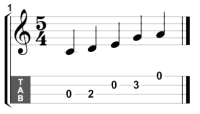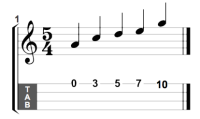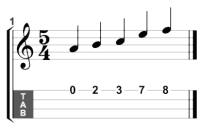scale
The term scale implies that it is a series of notes separated by a fixed distance from each other, like the steps of a staircase: You move up or down on the tones as you would on steps in even increments. However, it is a spiral „staircase“, because once you have completely gone, you come back to the same ladder; but in a higher or lower pitch. Learning and mastering the scales is an integral part of Ukulele Education, as Chalmers Doane states:
All tones of a scale can be played and harmonized using the rule of the octave.
Heptatonic
However, the heptatonic 2) used in Western music consists of five „whole“ steps and two „half“ steps between 7 root tones, which have been denoted since the Middle Ages with the letters abcdefg (or in capital letters, originally intended for the bass: ABCDEFG). The root tones are today usually denoted by capital letters. This is called „alphabetic“ (in contrast to the solmization.3)
Halftone steps
The two halftone steps are between B and C as well as E and F.
German notation
Unfortunately, in the Middle Ages a letter similar to b, the so-called b quadratum ♮, was used for the b. In German notation, this b quadratum became h (= H). By contrast, the b lowered by a semitone was written with the b rotundum ♭, which in the German notation is represented as b (= B). Thus, only in German notation the root tone series runs AHCDEFG.
Semitones
Between the „whole“ steps are still more tones, which are reached by semitone steps. These semitones have no names of their own, but are named after the stem tones between which they lie; sharp is added if they are half a tone above the reference root, and flat if they are below it. F and C can not be lowered because their distance to the previous note is anyway only a semitone (thus, F and C become E and B). This results in:
| Root tone | sharp | flat |
|---|---|---|
| A | A♯ | A♭ |
| B | (C) | B♭ |
| C | C♯ | (B) |
| D | D♯ | D♭ |
| E | (F) | E♭ |
| F | F♯ | (E) |
| G | G♯ | G♭ |
Enharmonic equivalent
If the distance between root tones and semitones when used in musical instruments actually consists of one half of a whole-tone step (pure tuning) – which is the case with the ukulele as with other stringed instruments –, a root tone increased by a semitone step and the following root tone reduced by a semitone step would be identical; e.g., F# = G♭. In today's musical practice, it is simply pretended as if this were the case (enharmonic equivalent). Therefore, the complete (chromatic) scale with the possible semitone steps added consists only of twelve tones:
Major scale
A tone scale can be built on each tone, leading to the next highest octave in seven steps (five full, two half steps). If the semitone steps are on the 3rd and 7th step, this is called a major scale.
| Example: C major | ||||||||
|---|---|---|---|---|---|---|---|---|
| Position | 1 | 2 | 3 | 4 | 5 | 6 | 7 | 8 |
| Tone | C | D | E | F | G | A | B | C |
| Step | 1 | 1 | .5 | 1 | 1 | 1 | .5 | |
Minor scale
In a minor scale, however, the halftone steps are on the 2nd and 5th step respectively.
| Example: a minor | ||||||||
|---|---|---|---|---|---|---|---|---|
| Position | 1 | 2 | 3 | 4 | 5 | 6 | 7 | 8 |
| Tone | A | B | C | D | E | F | G | A |
| Step | 1 | .5 | 1 | 1 | .5 | 1 | 1 | |
Parallel
Each major scale has a parallel minor scale with the same notes (and signs), always one minor third lower.
| Major | Cb | C | C# | Db | D | Eb | E | F | F# | Gb | G | Ab | A | Bb | B |
|---|---|---|---|---|---|---|---|---|---|---|---|---|---|---|---|
| Minor | Abm | Am | A#m | Bbm | Bm | Cm | C#m | Dm | D#m | Ebm | Em | Fm | F#m | Gm | G#m |
Pentatonic
Older than the heptatonic scales, however, are pentatonic 7) scales. They were and still are used around the world – e.g. Africa, East Asia, but also Europe. In modern music (especially blues and jazz) they have become important again. This is also due to the fact that pentatonic scales can be played well on stringed instruments such as the guitar and ukulele.
Pentatonic without semitone steps
In the European conception, a pentatonic scale is formed without semitone steps („anhemitic“), in that the fundamental tone is followed by two whole-tone steps (large seconds), a minor third, and another whole-tone step. In this sequence, they are classified as major scale. As with the heptatonic scale, the tone sequence based on the 5th level is considered as parallel minor key. A pentatonic minor scale thus consists of a minor third, two whole-tone steps and another minor third.
On an ukulele (regardless of the tuning) both pentatonic scales can be played with ease:
- On one string: Gripping the frets with fret marks (3rd, 5th, 7th, 10th, 12th frets) results in a major scale; if the empty string is used first, the result is a minor scale (0th, 3rd, 5th, 7th, 10th fret). This pattern can be moved to each string (2nd / 4th / 6th / 9th / 11th fret or 4th / 6th / 8th / 11th / 13th fret).
- With moveable patterns for pentatonic scales that can be played across the entire fretboard.
Major example: Amazing Grace
Minor example: Haribo macht Kinder froh
Yonanuki
Particularly in traditional and popular Japanese music (enka) scales with semitones are also common. The so-called Yonanuki scale 8) omits the 4th and 7th steps of the respective heptatonic scale. In the major version, it thus corresponds to a pentatonic major scale without semitone steps. In the minor version, however, the halftone steps on the 2nd and 5th step are retained. Thus it consists of a big second (whole tone step), a small second (semitone step), a big third and a small second. This scale can also be played on the ukulele in a simple moveable pattern.
Yonanuki minor example : Sakura
| Jake Shimabukuro: Sakura |
|---|
Scales on the Ukulele
The following patterns are all ways to play diatonic scales on the ukulele. The major root note is highlighted in light blue, the minor root note is pink. The halftone steps are marked in red; they are omitted if a pentatonic scale is to be played. The fourth string is played only in a linear tuning and is therefore grayed out. The number to the left below the string names indicates which fret to start on when playing a C major scale.
The arrangement of the scales on the fretboard gives the modal scales according to the mnemonic: „I Don't Play Like Miles and Louis“.
References
- Andrews, Lee: Scales for Soprano Ukulele. Pacific: Mel Bay. 2008











